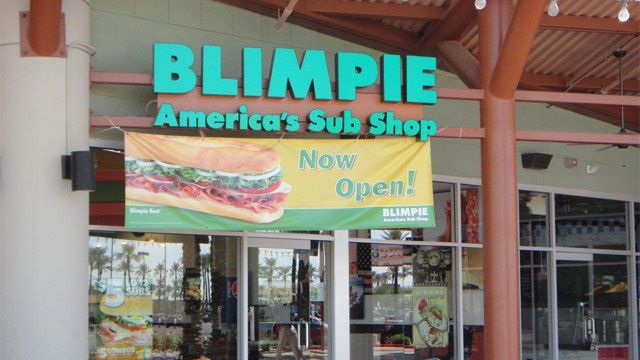Blimpie – Sub Sandwich Franchise

Blimpie is recognized as the oldest sandwich franchise chain in the U.S. The brand has been through a variety of turbulent swings and although the namesake still carries weight in the sandwich franchise market, the company changed ownership and did not benefit to a large extent from the massive expansion in the sandwich franchise market.
Blimpie was one of the most innovative sandwich franchise brands on the market. They were the first in the franchise segment to convert stores to non-conventional locations in gas stations, train stations, and other locations that were high traffic, but did not fit the traditional retail environment of a sandwich franchise business.
In the 1980s, the brand was the first in the sandwich franchise market to target the lower calorie menu options and use that as the focus of marketing the brand. Blimpie even utilized vending machines to sell the popular sandwiches, there were very few franchise brands who were ever as creative and out-of-the-box thinkers as Blimpie’s had been.
The Blimpie franchise advisory counsel was one of the first to operate in an official and substantial way leading the brand forward and offering innovative and effective input on how to improve the sandwich chain. In 1983, the Blimpie Sandwich Franchise went public and the brand grew to a peak of over 2,000 units.
What seemed to be Blimpie’s downfall was a lack of focus and overly aggressive growth. The sandwich franchise had sold primarily master franchises throughout the U.S. and globally with little regard for support and management of the expansive network of franchisees and master franchisees who needed support and infrastructure to deliver sustainable growth.
Blimpie’s also invested in several different businesses along the way with the consideration of integrating new brands into the franchise network and divesting ownership outside of just the sandwich franchise market. An investment in a Hawaiian taco chain, a smoothie café chain, and the saturation of Blimpie master franchise territories in the U.S. brought a halt to the aggressive growth of the brand and slowed the overall progress in what was quickly becoming the most competitive segment in franchising.
In 2001 Mr. Jeffrey Endervelt, a master franchise for the brand in California, purchased the rights to the Blimpie franchise network and moved to focus the growth of the brand back on what had made the model successful again. The franchise industry had proven with several brands that the sandwich market was an extremely profitable and effective market segment within franchising.
In 2014 Mr. Endervelt hired Franchise Marketing Systems (FMS) to develop a franchise strategic plan to lead the sandwich franchise into a growth model that could be not only effective in recruiting new franchisees but also in sustaining profitable, long-term growth at the unit level.
FMS worked with Blimpie management to define the buyer profile and rework the sandwich franchise model to create a plan that could allow for sales goals to be achieved. When the team of franchise consultants began to work with Blimpie, there were several aspects of the franchise program came to the forefront.
One, the brand still carried value and meant a great deal to a large segment of consumers and franchise investors. In particular, those with any history in the Northeastern U.S. still felt strongly about Blimpie’s brand.
Second, Blimpie’s had a great product that could compete with any of the sandwich franchise chains on the market, most consumers were not aware of this. Third, the unit-level economics were in the upper tier of performance for the sandwich franchise market and needed to be showcased to potential investors.
Finally, Blimpie’s had opportunities to expand into some markets where there were significant holes in market coverage, and with the right franchisees, there could be amazing opportunities for both the brand and the franchise investors who were willing to take the risk and invest with the brand.
The FMS team of franchise consultants recommended that the focus for new recruitment should only be to qualified investors, not single-unit operators. The model could work as a single unit, but the economics for both franchisor and franchisee were significantly better when dealing with multi-unit franchisees.
The Blimpie’s franchise network still had over 500 stores and a long track record behind it, these aspects could be leveraged and when presented correctly create value and excitement for the brand. The focus for new growth was to target key markets where ideal demographics and customer characteristics existed to maximize ROI for early franchise investors. Franchise Marketing Systems developed the marketing model, sales tools, and overall franchise development strategy to take Blimpie forward and grow the brand.
For more information on how to franchise your Sandwich Business, Contact us here:
- How does the Stark Law work in Franchise Business Models: Legal Considerations and Compliance - January 25, 2024
- Jollibee Franchise: A Flavorful Journey Through History - January 25, 2024
- How Franchisors Tackle Daily Challenges in Business Management - January 23, 2024

